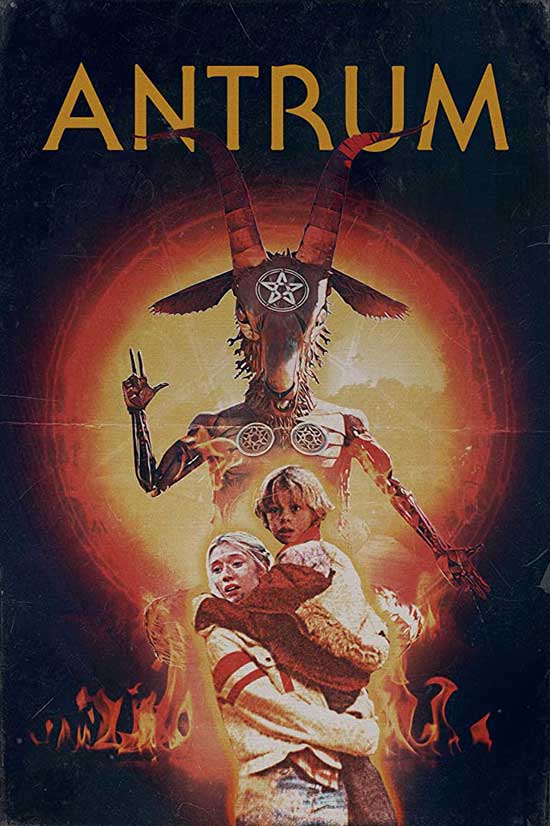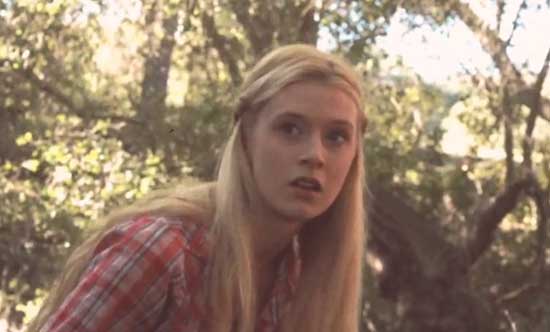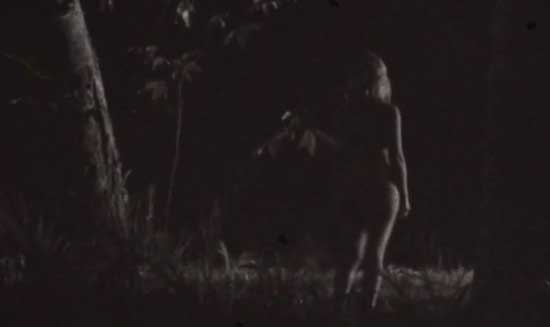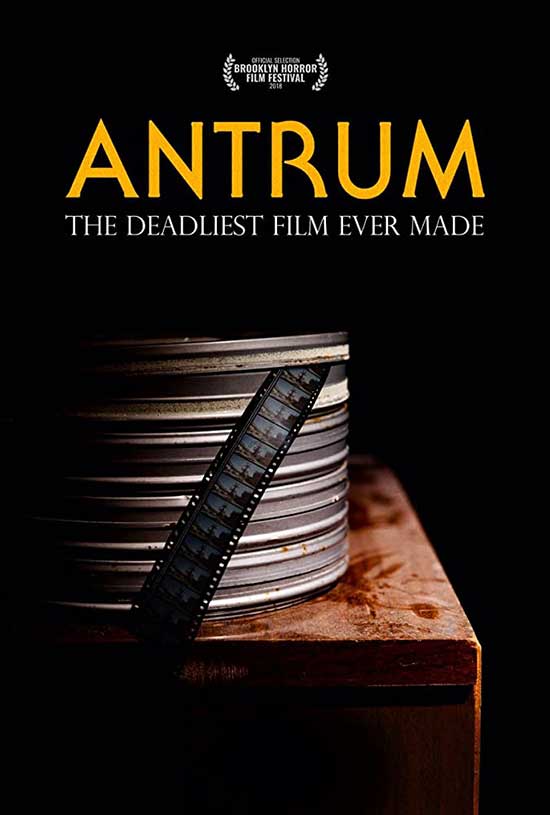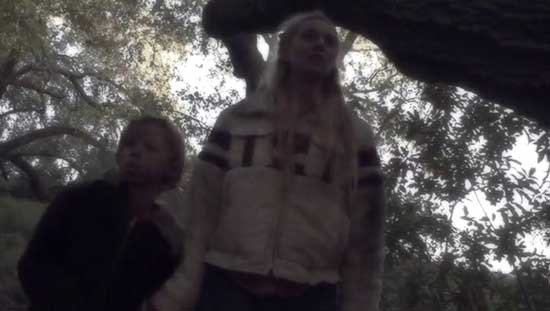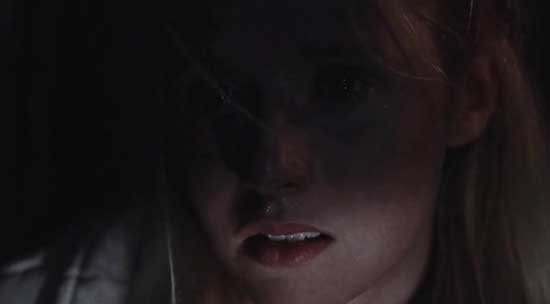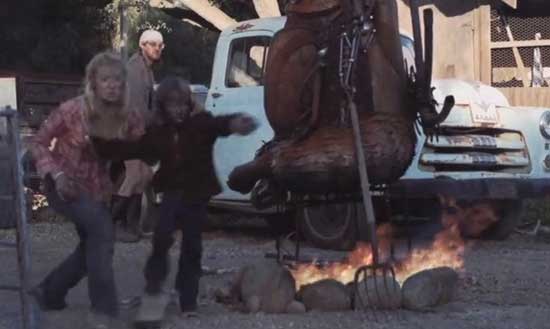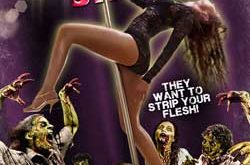SYNOPSIS:
Framed as a lost 1970’s film, Antrum follows a sister and her kid brother as they seek to dig a hole to Hell and rescue the soul of their dog, allowing terrifying supernatural powers to slowly engulf them.
REVIEW:
Directors: David Amito & Michael Laicini
Writers: David Amito (screenplay, story) & Michael Laicini (story)
Starring: Nicole Tompkins, Rowan Smyth, Dan Istrate, Circus-Szalewski, Shy Sakimoto
Antrum: The Deadliest Film Every Made (2018) is an odd beast, and anyone interested in viewing it should be made aware of that right away. The film features a framing mockumentary about the titular “lost” 70’s film (a modern-retro affair) which caused numerous mysterious deaths and was rarely screened. The encapsulated film is a lyrical fairytale-like feature where a teenage girl named Oralee (Nicole Tompkins, The Amityville Terror 2016) fabricates a story about a place in the woods where the underworld can be reached in an attempt to help end her brother Nathan’s (Rowan Smyth, A Psycho’s Path 2019) nightmares about their dog’s soul residing in Hell. Unfortunately for the siblings, Hell maybe real, and the woods are occupied by the demonic bumpkins Cassius (Dan Istrate, Drakul 2017) and Hanzie (Circus-Szalewski, Dirty Dealing 3D 2018). The feature is directed and written by David Amito (director of the stageshow-turned-film Beautiful Word… 2006), with Michael Laicini (headwriter for the Who is Mr. Tom? series 2012) co-directing and co-developing the story.
“Fine,” you say, “but should I watch it?” To put it bluntly, I recommend Antrum to lovers of understated 60’s and 70’s horror films only (think of the better Incubus from 1966 or the worse Touch of Satan from 1971). For anyone else, the heavy use of fake film-grit and long stretches of silence emphasized by strained dialogue may, in fact, drive you to a mysterious death. With that said, the film grain was a good touch, though I found it a smidgen too much; the slight overuse revealed it to be a post-production filter instead of any old-school type of film-dirtying, and it would’ve been lovely to have the movie actually shot on film. That can be forgiven, however, as it would have been far more cost prohibitive, and the crew did well by attaining the high color saturation and blown-out light sources that typified 70’s films.
There were some cracks in this retro veneer, though, such as in the late-runtime flashback where little Nathan was beckoned by a devil behind what appears to be a supermarket. In that scene, the modernity of the setting was too blaringly obvious, and I wish the filmmakers had done more to mask it, given how well they’d succeeded.
This is a small misstep, though, and the film also features neatly crafted pen drawings of various deviltry in the sibling’s guidebook to Hell. This book is part of interesting chapter breaks in the film marking the duo’s descent into the deeper spheres of Hell. Moments like these show the legendary witchcraft-pic Häxan’s (1922) heavy influence on the filmmakers, which would be obvious to the enlightened even without the framing story’s overly thorough use of footage from said classic flick. Antrum isn’t only a retread, though, as the movie includes a few neat additions to the demoniac formula, such as numerous subliminal images and a moody deep soundtrack (the latter is sure to make lovers of The Exorcist’s bass-stings happy.)
Ultimately for this hippie-era horror lover, the biggest weakness in Antrum is the framing story. It isn’t poorly done—in fact, it looks like a slice of a contemporary documentary that Netflix or Hulu would snap up in their never-ending search for content. The problem is that it doesn’t fit with the film. This isn’t The Exorcist; it’s not a movie that, had it really been from the 1970’s, would’ve been expected to inflict a demonic death-effect on unsuspecting viewers. A simple title card at the movie’s start advertising it as formerly lost movie would’ve meshed with the movie’s vibe more smartly, and detracted from its dreamy mood less. There’s also a dipping of quality to the docu-segments, as those post-film are far less believable and try to force in a much more ominous tone than the whole affair merits.
These aren’t the only issues Antrum has—the inner film’s ending is an unnecessary and improbable tragedy of errors, and there’s some dull Hostel-esque footage spliced into the movie from “unknown” sources, per the mockumentary commentary. But those don’t detract enough to lessen my joy at finding a film that nailed the late 1960’s, early 1970’s attitude and presentation this well. If such a pic sounds right up your demon-claimed meadow, don’t hesitate to give Antrum a watch.
 Horror News | HNN Official Site | Horror Movies,Trailers, Reviews
Horror News | HNN Official Site | Horror Movies,Trailers, Reviews
